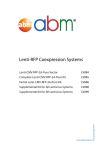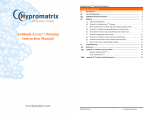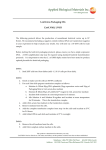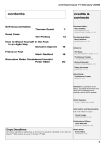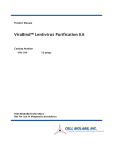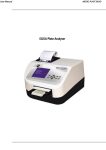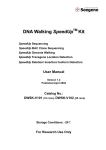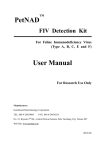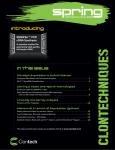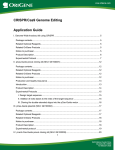Download Lenti-Bicistronic & Tricistronic Expression Systems
Transcript
Lenti-Bicistronic & Tricistronic Expression Systems Lenti-Bicistronic Vector LV037 Lenti-Tricistronic Vector LV038 Complete Lenti-Bicistronic Expression Kit LV039 Complete Lenti-Tricistronic Expression Kit LV040 Partial Lenti-Bicistronic Expression Kit LV041 Partial Lenti-Tricistronic Expression Kit LV042 Supplemental Kit for All Lentivirus Systems LV098 Supplemental Kit for All Lentivirus Systems LV099 www.abmGood.com www.abmGood.com Table of Contents Notice to the Purchaser 1 Technical Support 1 Biosafety 2 Protocol at a Glance 3 Lenti-Bi/Tri-cistronic Expression System 5 General Information about Lentiviral Vectors How Lentiviruses Work VSV Glycoprotein Envelope Packaging Limits 6 6 6 6 Materials 7 Additional Materials Required Storage 7 7 Protocol 8 Packaging Mix 293T Cells Positive Control Transfection Procedure Concentrating Virus Long-Term Storage Viral Titre Assays Transduction Procedure 8 8 8 9 10 11 11 12 Troubleshooting 14 References 15 Contact Information 16 Lenti-Bicitronic & Tricistronic Handbook Notice to the Purchaser The products are for research use only. Use in and/or for diagnostics or therapeutics is strictly prohibited. By opening and using the product, the purchaser agrees to the following: The components in this kit may not be distributed, resold, or modified for resale without prior written approval from Applied Biological Materials (abm) Inc. If you do not agree to the above conditions, please return the UNOPENED product to abm Inc. within ten (10) days of receipt for a full refund. The information in this document is subject to change without notice and should not be construed as a commitment by abm Inc. or its affiliated corporations. In no event shall abm Inc. or its affiliated corporations be liable for incidental or consequential damages in connection with or arising from the use of this manual and product. abm Inc. products are warranted to meet our QC testing standards at the time of shipment. Notice of problematic products must be made to abm Inc. within 15 days of receipt of the product. This product warranty limits abm Inc.’s liability to the replacement of the product only. Technical Support For more information on abm Inc. products, please visit our website: http://www.abmGood.com For additional information or technical assistance, please call or email us at: Applied Biological Materials, Inc. Phone: (604) 247-2416 1-866-757-2414 Fax: (604) 247-2414 E-mail: [email protected] Page 1 of 16 Lenti-Bi/Tri-cistronic Handbook Biosafety Our Lenti-Bi/Tri-cistronic Expression System employs 3rd generation self-inactivating recombinant lentiviral vectors with enhanced biosafety and minimal relation to the wild-type, human HIV-1 virus. The lentiviral particles produced with this system are replication-incompetent and designed with a number of safety features to enhance its biosafety. All Lentiviral Expression Systems provided from abm Inc. include the following safety features: • An enhancer deletion in the U3 region of 3’ΔLTR ensures self-inactivation of the lentiviral vector following transduction & integration into the target cell’s genomic DNA. • Utilization of a RSV promoter upstream of 5’ΔLTR allows efficient Tet-independent production of viral RNA. • The number of lentiviral genes necessary for packaging, replication and transduction is limited to three (Gag/Pol/Rev), and their expression is derived from different plasmids, all lacking packaging signals. The plasmids share no significant homology to the expression vector, preventing the generation of replication-competent virus. • None of the Gag, Pol, or Rev genes will be present in the packaged viral genome, thus making the mature virus replication-incompetent. Despite the safety features discussed above, it is highly recommended that all manipulation with lentiviral vectors, including viral production and transduction, be performed under Biosafety Level 2 (BL-2). All published BL-2 guidelines with proper waste decontamination should be strictly followed. In addition, exercise extra caution when creating lentivirus carrying potentially harmful or toxic genes (e.g. oncogenes). For more information about the BL-2 guidelines and lentivirus handling, refer to “Biosafety in Microbiological and Biomedical Laboratories,” 5th Edition. This may be downloaded at: www.cdc.gov/biosafety/publications/bmbl5/index.htm It is also important to consult with the health and safety officer(s) at your institution for guidelines regarding the use of lentiviruses, and to always follow standard microbiological practices, which include: • Wear gloves and a lab coat at all times. • Always work with pseudoviral particles in a Class II culture facility and that all procedures are performed carefully to minimize splashes and aerosols. • Work surfaces are decontaminated at least once a day and after any spills of viable material. • All cultures, stocks and other regulated wastes are decontaminated before disposal by an approved decontamination method, like autoclaving. Lenti-Bi/Tri-cistronic Handbook Page 2 of 16 Protocol at a Glance Packaging Mix Expression Vector 293T Cells Step 1 Co-transfect 293T cells with a lentiviral vector and packaging mix. Pseudoviral Particles Step 2 Collect viral particles and determine titre. Target Cells Step 3 Infect Target Cells Target Cells Transduced Step 4 Assay Cells Figure 1: Procedure for Transient Production of Pseudoviral Particles and Transduction of Target Cells. Page 3 of 16 Lenti-Bi/Tri-cistronic Handbook Figure 2: Map of pLenti-Bi-cistronic & pLenti-Tri-cistronic Lenti-Bi/Tri-cistronic Handbook Page 4 of 16 Lenti-Bi/Tri-cistronic Expression System Lenti-Bi/Tri Simultaneous expression of two or three genes by a single lentivector is often required for a diverse range of applications. Until now, IRES-based elements were used for these particular applications. However, it has been well documented that the gene down-stream of IRES exhibits only low level transgene expression. In addition, the IRES element is relatively large in size (>800bp) and its use is often limited due to the lentiviral packaging capability (<5.0kb). So development of a promoter system with bi-directional functionality was needed for simultaneous expression of two or three genes by a single lentiviral vector. Now, the bicistronic vector, that is superior to IRES-based two gene expression systems because its smaller size (500bp) and stronger expression signal for both genes (Amendola et al., 2005), and with the addition of a T2A peptide to the tricistronic vector, up to 3 different genes can be expressed from the same lentiviral vector (Tang et al., 2009). The Lenti-Bi/Tri-cistronic Expression System allows production of replication-incompetent 3rd generation lentivirus that can stably transduce both dividing and non-dividing mammalian cells with high efficiency (Naldini, 1998 and Dull et al., 1998). Our lentiviral expression vector has been fully optimized for simple manipulations such as subcloning the gene of interest into our pLenti-expression vector, and easy viral DNA production including maxi DNA purification. The vector simply works like any other plasmid. In fact, our vectors are so stable that non-specific recombination or rearrangement in regular DH5a bacteria cells is rarely observed. This is a significant advantage compared to similar lentiviral vectors offered by other companies, which are associated with substantial adversity in subcloning and DNA production. Because of our vector stability, there is no need for special competent cells during transformation. A general procedure for lentiviral production is shown in figure 1 on page 3. Our lentiviral vectors are 3rd-generation and are compatible with packaging mixes that support the production of both 2nd and 3rd-generation vectors. Our optimized Lenti-Combo Mix (LV003) supplies all the structural and replication proteins in-trans that are required for high-titre lentivirus production in packaging cells (Titres can be obtained up to 107IU/ml). Figure 2 on page 4 shows the vector map for the pLenti-Bi/Tri-cistronic vector used in this kit. Page 5 of 16 Lenti-Bi/Tri-cistronic Handbook General Information about Lentiviral Vectors Morphology: Virions consist of an envelope, a nucleocapsid, a nucleoid, and matrix proteins. The enveloped virions assume a spherical to pleomorphic shape of 80-100nm in diameter. The virion surface is covered with dense inconspicuous spikes of 8 nm in length. Physical Properties: Virions have a buoyant density of 1.13-1.18g/cm3 in sucrose. Virions are sensitive to treatment with heat, detergents, and formaldehyde. The infectivity is not affected by irradiation. How Lentiviruses Work Once target cells are transduced with a recombinant lentivirus, the viral RNA is reverse-transcribed, actively imported into the nucleus (Lewis & Emerman, 1994; Naldini, 1999), and undergoes stable integration into the host genome (Buchschacher & Wong-Staal, 2000; Luciw, 1996). One or two days after the lentiviral genome is integrated into the host genome, you may begin to assay for the transient expression of your recombinant protein or use appropriate selection markers to generate a stable cell line for long-term expression studies. VSV Glycoprotein Envelope Most commercial retroviral vectors are limited in gene delivery applications because of their restricted tropisms and generally low titres. For recombinant lentiviral vectors, these limitations are resolved by pseudotyping the vector with the G glycoprotein gene from Vesicular Stomatitis Virus Glycoprotein (VSV-G) envelope. The significant advantages associated with the use of VSV-G envelope include: • allowing production of high titre lentiviral vectors • increasing viral particle stability • broadening target cell ranges • generating highly efficient transduction efficiency (Burns et al., 1993; Emi et al., 1991; Yee et al.,1987, 1994, 1999). Packaging Limits Recombinant lentiviral titres will decrease with increasing insert gene size. The packaging limit for our Lenti-Bi/Tri-cistronic expression system is approximately 5.5 kb; above these limits, little to no virus will be produced. Lenti-Bi/Tri-cistronic Handbook Page 6 of 16 Lenti-Bi/Tri Lenti-Bi/Tri-cistronic Expression System Materials Lenti-Bi/Tri Scientists at abm have successfully developed a comprehensive product line for gene expression, and reagents for packaging viral particles. In addition, ready-to-use lentiviral particles are also available for immediate transduction of any target cells as in shown in Table I. Table I. Lenti-Bi/Tri-cistronic Vector and Kits Component Kit Cat. No. Cat. # Quantity LV039 LV040 LV041 LV042 LV098 LV099 Lenti-Bicistronic Vector LV037 Lenti-Tricistronic Vector LV038 Packaging Mix LV003 100ul LentifectinTM G074 1.0ml 293T Cells LV010 1x106 LV011-a 10ug Lenti-GFP Vector 10ug 10ug Additional Materials Required The following materials and reagents are required but not provided: • Dulbecco’s Modified Eagle’s Medium (Invitrogen Cat: 11995) • Fetal bovine serum (FBS) (Cat. No. TM999-500) Note: does not need to be heat-inactivated. • 200 mM L-Glutamine (Sigma Cat. No. G7513) • Solution of 10,000 units/ml Penicillin G sodium and 10,000 μg/ml Streptomycin sulphate (Sigma Cat. No. P0781) • Complete Medium: DMEM supplemented with 100 units/ml penicillin G sodium, 100 μg/ml streptomycin and 10% fetal bovine serum (FBS) • Puromycin (Cat. No. C021) • Polybrene (Hexadimethrine Bromide; Cat. No. G062) • Trypsin-EDTA (Trypsin; Sigma Cat. No. T3924) • Dulbecco’s phosphate buffered saline (DPBS; VWR Cat. No. 82020-066) • Tissue culture plates and flasks Storage • 293T Cells in Liquid Nitrogen. • Lentifectin at 4°C. • All other components at -20°C. • Spin briefly to recover contents and avoid repeated freeze-thaw cycles. Page 7 of 16 Lenti-Bi/Tri-cistronic Handbook NOTE: The following protocol is broken into sections for convenience. However, time should be taken to read through the full procedure before attempting. Lenti-Bi/Tri-cistronic Construct Generation Generate a pLenti-Bi/Tri-cistronic expression vector containing your gene of interest. For information on subcloning using the multiple cloning sites available in our lentiviral vectors, refer to a standard molecular cloning manual (Sambrook, J.& Russell, D.W.). Once the expression construct has been produced, perform a Maxi DNA purification for transfection. Packaging Mix All plasmids required for the production of recombinant lentiviruses are provided in optimized mixtures. We have developed two different packaging mixes for producing recombinant lentiviral particles in either 2nd or 3rd generation lentiviral vectors. 2nd Generation Packaging System Mix (Cat. No. LV003) is used for the production of 2nd generation lentiviral particles and 3rd Generation Packaging System Mix (Cat. No. LV053) is used for the packaging of 3rd generation lentiviral particles. All lentiviral expression vectors provided by abm Inc. are of 3rd generation and can be packaged by either 2nd or 3rd Generation Packaging Mixes. In general, relatively higher titres can be achieved with the 2nd Generation Packaging System Mix, but lentiviral particles packaged with the 3rd Generation Mix have a higher safety profile. 293T Cells The 293T cell line is widely used for optimal cell line for lentivirus production (Naldini et al., 1996). The health of 293T cells at the time of transfection is a critical factor for the success of lentivirus production. The use of “unhealthy” cells will negatively affect the transfection efficiency, resulting in lower titre lentiviral stocks. For optimal lentivirus production, follow the guidelines below to culture 293T cells before use in transfection: • ensure cell viability is greater than 90%. • subculture and maintain cells in complete medium containing 0.1mM MEM, Non-Essential Amino Acids, 4mM L-Glutamine, 1mM sodium pyruvate, • 10% FBS. • do not allow cells to overgrow before passaging. • use cells that have been subcultured for less than 16 passages. Positive Control We recommend using a positive control vector such as pLenti-GFP to generate a control lentiviral stock that can be used to help you optimize expression conditions in your target cells. Lenti-Bi/Tri-cistronic Handbook Page 8 of 16 Lenti-Bi/Tri Protocol Protocol Lenti-Bi/Tri A. Transfection Procedure We produce lentiviral stocks in 293 cells using the following optimized transfection conditions. The amount of lentivirus produced using these recommended conditions (10ml of virus at a titre of at least 1x105 transducing units (TU)/ml) is generally sufficient to transduce at least 1x106 cells at a multiplicity of infection (MOI) of 1; higher titre lentivirus can be produced by scaling up transfection. For example, 10 wells of cells plated at 1x105 cells/ well in 6-well plates could each be transduced with 1ml of a 1x105 TU/ml virus stock to achieve an MOI of 1. 1. One day before transfection (Day 1), plate 293T cells in a 10cm tissue culture plate so that they will be 90-95% confluent on the day of transfection (i.e. 5x106 cells in 10ml of growth medium containing serum). As a rule, one 15cm culture dish at 95% confluence can be subcultured into five 10cm dishes; while one 10cm dish at 95% confluence can be subcultured to two 10cm dishes. 2. On the day of transfection (Day 2), set up the transfection mix: a. In a sterile 15ml culture tube, dilute 15μg of Lenti-Combo Mix and 10μg of pLenti expression plasmid DNA in 1.0ml of medium without serum. Mix gently. b. In a separate sterile 15ml tube, dilute 80μl of Lentifectin (mix gently before use) in 1.0ml of medium without serum. Mix gently and incubate for 5 minutes at room temperature. c. After the 5 minutes of incubation, combine the diluted DNA with the diluted Lentifectin. Mix gently. d. Incubate for 20 minutes at room temperature to allow the Lentifectin/DNA complexes to form. e. Add 4.5ml serum-free medium to the complexes followed by gently mixing. f. Remove the medium from the cells, and then add Lentifectin/ DNA complexes carefully to culture dishes without dislodging cells. Incubate the cells for 5-8 hours at 37°C in a humidified 5% CO2 incubator. Note: 293T cells are poorly adhesive to most culture dishes. It is always recommended to add or change medium against the wall of culture dishes to avoid dislodging cells. Page 9 of 16 Lenti-Bi/Tri-cistronic Handbook g. Add 0.65ml serum to each transfected culture dish and return the dishes to incubator. Incubate overnight. 3. The following day (Day 3), remove the medium containing the Lentifectin/DNA complexes and replace with 10ml complete culture medium. Incubate at 37°C in a humidified 5% CO2 incubator. Note: Expression of the VSVG glycoprotein can cause 293T cells to fuse, resulting in the appearance of large, multinucleated cells known as syncytia. This morphological change is normal and does not affect production of the lentivirus. 4. Harvest virus-containing supernatants 48-72hrs post-transfection (Day 4-5) by collecting medium into to a 15ml sterile, capped, conical tube. Caution: Remember that you are now working with infec- tious virus at this stage. Follow the recommended guidelines for working with BL-2 organisms (see page 3 for more information). 5. Centrifuge supernatants at 3000rpm for 15 min. at 4°C to pellet debris. Optional: Filter the viral supernatant through 0.45μm PVDF syringe filter (Millipore, Cat. No. SLHVR25LS). 6. Aliquot viral supernatants into cryovials in 1.0ml portions and store viral stocks at -80°C. Proceed to titre your lentiviral stock (page 10). Note: If you plan to use your lentiviral construct for in vivo applications, we recommend filtering your viral supernatant through a sterile, 0.45μm low protein binding filter after the low-speed centrifugation step to remove any remaining cellular debris. The viral supernatant can be concentrated using the protocols discussed in the following section if higher titre virus is required. B.Concentrating Virus There are many protocols that have been established to concentrate VSVG pseudotyped lentiviruses without significantly affecting their ability to transduce target cells. These include ultracentrifugation (Yee, 1999), filterbased ion exchange chromatography (Ultra-Pure Cat. No. LV998), and size exclusion chromatography (Speedy Lentivirus Purification Cat. No. LV999). However, we would strongly recommend using abm’s Ultra-Pure Lentivirus Purification Kit (Cat. No. LV998) for pLenti-miR vector concentration and purification based on our in-house testing data. Lenti-Bi/Tri-cistronic Handbook Page 10 of 16 Lenti-Bi/Tri Protocol Protocol Lenti-Bi/Tri C. Long Term Storage Viral stocks stored at -80°C should be stable for at least one year. Repeated freeze/thaw cycles will result in a loss of viral titre. Based on our in-house data, each freeze/thaw will lead to a 25% loss of viral titre. D.Viral Titre Assays It is useful to titre the viral supernatant before proceeding with the transduction experiments for the following reasons: • To ensure that viral stock is viable. • To determine the percentage of target cells that can be transduced with the pseudoviral stock. • To control the number of copies of viral constructs per target cell. The commonly used protocol for measuring relative titres uses a positive control expression plasmid (i.e. GFP mixed with expression construct) as an internal control at a ratio of 1:100 and is packaged into pseudoviral particles. In an alternative approach, the GFP control plasmid can be packaged separately but in parallel with your construct, as an external control. In this scenario, the control plasmid can be used to check and optimize the transfection/packaging steps (see transfection procedure). Recently, other in vitro protocols including qRCR and HIV p24 protein-based ELISA have been developed for quick assays. To determine the relative titre, transduce a target cell line, like MDAMB-468, in the presence of Polybrene (2μg/ml) for 12-16 hrs, and then count the number of cells expressing GFP either by fluorescence microscopy or FACS. 1. For each viral stock, plate MDA-MB-468 cells one day prior to viral infection in a 24-well plate at a density of 0.6-1x105 cells per well. Add 1ml of complete D-MEM medium (with serum and antibiotics) and incubate cells at 37°C with 5% CO2 overnight. Note: It is possible to use bigger culture dishes for transduction, especially when a large number of cells is needed for FACS analysis. In this case, the amount of cells should be adjusted based on the growth area of the dish. 2. Prepare complete D-MEM medium plus 10% FBS with Polybrene to a final concentration of 2μg/ml. Note: Polybrene is a polycation that neutralizes charge interactions to increase binding between the pseudoviral capsid and the cellular membrane. The optimal concentration of Polybrene depends on cell type and may need to be empirically determined (usually in the range of 1–8μg/ml). Excessive exposure to Polybrene (>12 hr) can be toxic to some cells. Page 11 of 16 Lenti-Bi/Tri-cistronic Handbook 3. Remove culture medium and replace with 0.5ml of complete DMEM medium with 10% serum and Polybrene (from Step 2). For each viral stock, use three wells. Infect MDA-MB-468 cells by adding 1ul of viral stock into the first well (dilution factor of 500), 10μl of viral stock into the second well (dilution factor of 50), and 100μl of viral stock into the last well (dilution factor of 5). For controls, add 0.5ml of DMEM medium with Polybrene (from Step 2). Incubate at 37°C with 5% CO2 overnight. 4. Remove culture medium and replace with 1ml of complete DMEM medium (without Polybrene). Incubate the cells at 37°C with 5% CO2 overnight. 5. The following day, split the cells 1:3 to 1:5, if necessary, depending on the growth rate of cells. Incubate in complete D-MEM for an additional 24-48 hours. 6. Count the fraction of fluorescent cells by FACS analysis. You may also count the GFP positive cells under a fluorescent microscope, but the results may be less accurate due to inconsistencies in counting methods. Use an average of the fraction of GFP+ cells in 5 – 10 random fields to estimate the overall percentage of GFP+cells on the plate. Multiply the number of infected cells by 1.5×105 (in this example, the expected number of MDA-MB-468 cells on the plate at the moment of infection) and by the corresponding dilution factor, then divide by 0.5ml to determine the relative titre of the virus in the supernatant. Alternatively, the viral titre can also be estimated by real time PCR using ABM’s Lentiviral qPCR Titre Kit (Cat. No. LV500) or p24-based ELISA titre kit (Cat. No. LV501). E.Transduction Procedure The following information should be considered before one attempts target cell transduction: - The transduction efficiency of target cells varies significantly under different experimental conditions, including virus concentration, exposure time to virus, and growth area of cells. To determine the viral concentration required to provide the desired multiplicity of infection (MOI) for your target cells, perform several transductions with different concentrations of viral particles containing GFP control plasmid. Results from these test transductions should be used to determine an optimal concentration that yields the highest percentage of infected cells. Lenti-Bi/Tri-cistronic Handbook Page 12 of 16 Lenti-Bi/Tri Protocol Lenti-Bi/Tri Protocol - Recombinant gene expression can be measured directly 48 – 72 hours after transduction (“transient transduction”), but selecting stably transduced cells will require additional time after transduction. The decision to use “transiently transduced” cells or selected stable cells will depend on the nature of your target cells, biological assay, and transduction efficiency. For efficient transducable cells (e.g., 293, HT1080, HeLa, MDA-MB-468 cells, etc), most biological assays can be performed following transient transduction. However, for “difficult-to-transduce” cells, it is desirable to select the clones that stably expresses the Lentivector construct for experimental assays. The following provides general guidelines as a starting point for determining optimal conditions for target cell transduction: 1. Plate target cells in a 24-well plate 24 hours prior to viral infection at a density of 0.5×105 cells per well. Add 0.5 ml of complete optimal medium (with serum and antibiotics) and incubate cells at 37°C with 5% CO2 overnight. Note: It is possible to use other plate formats for transduction. In this case, the amount of cells should be adjusted depending on the growth area of the well/plate. 2. Prepare a mixture of complete media with Polybrene at a concentration of 2μg/ml. Remove media from the wells and replace with 0.5ml of the Polybrene/media mixture per well (for 24-well plate). 3. Infect target cells by adding several different amounts of viral stock (example: 1μl, 5μl , 10μl, and 100μl of virus). In addition, include a transduction well with GFP positive control virus and other appropriate positive and negative control viral constructs. Incubate cells at 37°C with 5% CO2 overnight. 4. Remove the culture medium and replace with 1ml of complete medium. Incubate cells at 37°C with 5% CO2 overnight. 5. The following day, split the cells 1:3 to 1:5, depending on the growth rate of your target cells, and continue incubating for 48 hours in complete DMEM. 6. The infected target cells can be either analyzed for transient expression or selected for stable expression using appropriate selection markers. Page 13 of 16 Lenti-Bi/Tri-cistronic Handbook Troubleshooting Problem Possible Cause Solution No Viral Particles Lenti-Bi/Tri-cistronic DNA modified (e.g. acetylation or methylation). Re-transform plasmid into an authetic DH5a. Low Viral Titre Low transfection efficiency: -poor quality DNA. -low 293T viability. -transfection media containing antibiotics and serum. -Purify DNA with an endotoxin-free Maxi colomn. -Use 293T cells under passage 16. -Reduce transfection antibiotic or serum efficiency. Low transfection efficiency. Optimize calcium transfection procedure. Insufficient DNA used for transfection. Use 30-50ug of expression vector and 30-50ug of packaging mix. 293T cell density too low. Optimal cell density is 90-95%. Viral supernatan harvested too early. Optimal viral titres can be collected 48-72 hours post-transfection. Viral supernatant subjected to multiple freeze-thaw cycles. Each freeze/thaw cycle can lose 25% of the titre. Make aliquots for long-term storage. Polybrene not used during transduction. Transduce cells in the presence of polybrene. Promoter silencing. Lentiviral vector may integrate into a chromosomal region that silences the promoter. Screen multiple antibioticresistant clones and select the one with the highest expresssion levels. MOI too low. Use maximum MOI for cell transduction. This is very critical for Tet-expression vectors. Viral stocks stored incorrectly. Aliquot and store at -80C. Avoid freeze/thaw cycles. Target cells not transducible with lentiviral vectors. Transduce target cells in the presence of polybrene. No Transgene Expression Antibiotic concentration too high. Determine antibiotic sensitivity of target cells by performing a killing curve. Use minimum antibiotic concentration required. Cells harvested too early for assay. Perform expression assay 3-4 days posttransduction and induction to allow the accumulation of expressed protein. Cytoxic Effects of Target Cells Large volume of viral supernatant used for transduction. Dilute viral supernatant 1:2 to 1:3 during transduction. Polybrene concentration too high. Use less or omit polybrene during transduction. Antibiotic concentration too high. Use minimum antibiotics for effective selection. Gene of interest toxic to cells. Lenti-Bi/Tri-cistronic Handbook Try a different cell line. Page 14 of 16 References Buchschacher, G. L., Jr., and Wong-Staal, F. (2000) Development of Lentiviral Vectors for Gene Therapy for Human Diseases. Blood 95, 2499-2504 Burns, J. C., Friedmann, T., Driever, W., Burrascano, M., and Yee, J.-K. (1993) Vesicular Stomatitis Virus G Pseudotyped Retroviral Vectors: Concentration to a Very High Titer and Efficient Gene Transfer into Mammalian and Nonmammalian Cells. Proc. Natl. Acad. Sci. USA 90, 8033-8037 Dull, T., Zufferey, R., Kelly, M., Mandel, R. J., Nguyen, M., Trono, D., and Naldini, L. (1998) A Third-Generation Lentivirus Vector with a Conditional Packaging System. J. Virol. 72, 8463-8471 Emi, N., Friedmann, T., and Yee, J.-K. (1991) Pseudotype Formation of Murine Leukemia Virus with the G Protein of Vesicular Stomatitis Virus. J. Virol. 65, 1202-1207 Lewis, P. F., and Emerman, M. (1994) Passage Through Mitosis is Required for Oncoretroviruses but not for the Human Immunodeficiency Virus. J. Virol. 68, 510-516 Luciw, P. A. (1996) in Fields Virology (Fields, B. N., Knipe, D. M., Howley, P. M., Chanock, R. M., J. L., Monath, T. P., Roizman, B., and Straus, S. E., eds), 3rd Ed., pp. 1881-1975, Lippincott-Raven Publishers, Philadelphia, PA Naldini, L. (1998) Lentiviruses as Gene Transfer Agents for Delivery to Nondividing Cells. Curr. Opin.Biotechnol. 9, 457-463 Naldini, L. (1999) in The Development of Human Gene Therapy (Friedmann, T., ed), pp. 47-60, Cold Spring Harbor Laboratory Press, Cold Spring Harbor, NY Sambrook, J.& Russell, D.W. (2001) Molecular Cloning: A Laboratory Manual (Cold Spring Harbor Laboratory Press, Cold Spring Harbor, NY). Yee, J.-K., Miyanohara, A., LaPorte, P., Bouic, K., Burns, J. C., and Friedmann, T. (1994) A General Method for the Generation of High-Titer, Pantropic Retroviral Vectors: Highly Efficient Infection of Primary Hepatocytes. Proc. Natl. Acad. Sci. USA 91, 9564-9568 Yee, J. K. (1999) in The Development of Human Gene Therapy (Friedmann, T., ed), pp. 21-45, Cold Spring Harbor Laboratory Press, Cold Spring Harbor, NY Yee, J. K., Moores, J. C., Jolly, D. J., Wolff, J. A., Respess, J. G., and Friedmann, T. (1987) Gene Expression from Transcriptionally Disabled Retroviral Vectors. Proc. Natl. Acad. Sci. USA 84, 5197-5201 Page 15 of 16 Lenti-Bi/Tri-cistronic Handbook Contact Information Applied Biological Materials Inc. Website: Email: www.abmGood.com General Information: [email protected] Phone: Order Products: [email protected] (8:30am-4:30pm PST M-F) Toll Free: 1-866-757-2414 Local: (604) 247-2416 Fax: (604) 247-2414 (24Hr.) Address: Technical Support: [email protected] siRNA: Suite #8-13520 Crestwood Place Richmond, BC Canada V6V 2G2 [email protected] Business Development: [email protected] Distributors North America Canada Applied Biological Materials Inc. Tel: (604) 247-2416 / 1-866-757-2414 Fax: (604) 247-2414 www.abmGood.com United States Applied Biological Materials Inc. Tel: (604) 247-2416 / 1-866-757-2414 Fax: (604) 247-2414 www.abmGood.com Mexico Quimica Lavoisier S.A. de C.V. Tel: 52-333-848-8484 Email: [email protected] www.lavoisier.com.mx Australia Biosensis Pty Ltd. Tel: +61 43 166 5519 Email: [email protected] www.biosensis.com Belgium Gentaur Tel: 32 2 732 5688 Email: [email protected] www.gentaur.com France Gentaur Tel: 01 43 25 01 50 Email: [email protected] www.gentaur.com Germany BioCat GmbH Tel: +49 (0) 6221-714-1516 Email: [email protected] www.biocat.com India G Biosciences Tel: 0120-432-3330 Email: [email protected] www.GBiosciences.com Israel BioConsult Tel: 972-(0)2-566-7043 Email: [email protected] www.bioconsult.co.il Italy MICROTECH s.r.l. Tel: +39-0816107435 Email: [email protected] www.microtech.eu Japan Cosmo Bio Co. Ltd. Tel: 03-5632-9610/9620 Email: [email protected] www.cosmobio.co.jp Singapore Bio-REV PTE Tel: (65) 6273-3022 Email: [email protected] bio-rev.com South Korea CMI Biotech Tel: 02 444 7101 Email: [email protected] www.cmibio.com Taiwan Interlab Co. Ltd. Tel: +886-2-2736-7100 Email: [email protected] www.interlab.com.tw United Kingdom NBS Biologicals Ltd. Tel: +44 (0)1480 433875 Email: [email protected] www.nbsbio.co.uk International Lenti-Bi/Tri-cistronic Handbook Page 16 of 16





















